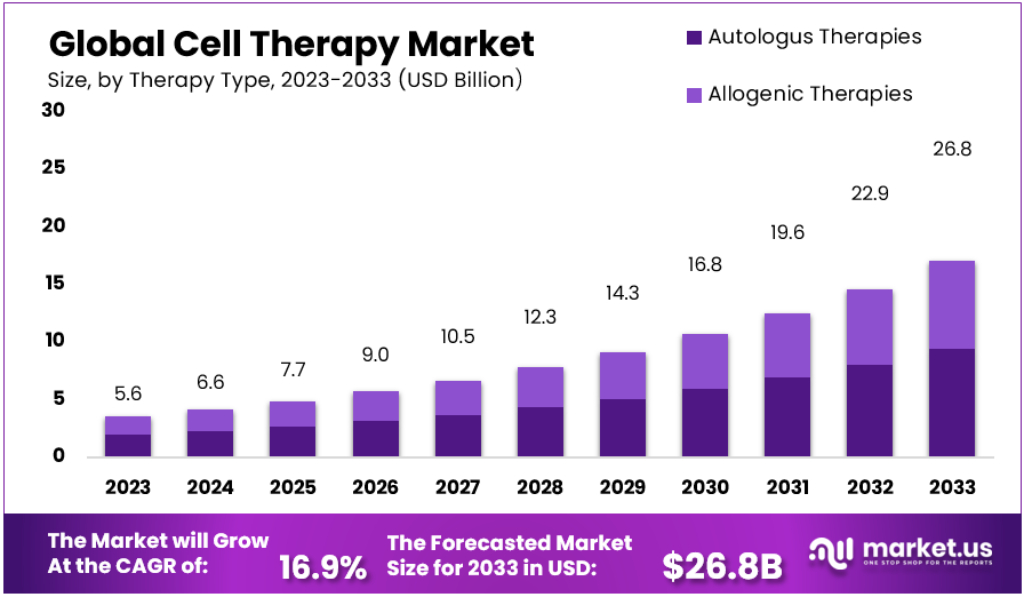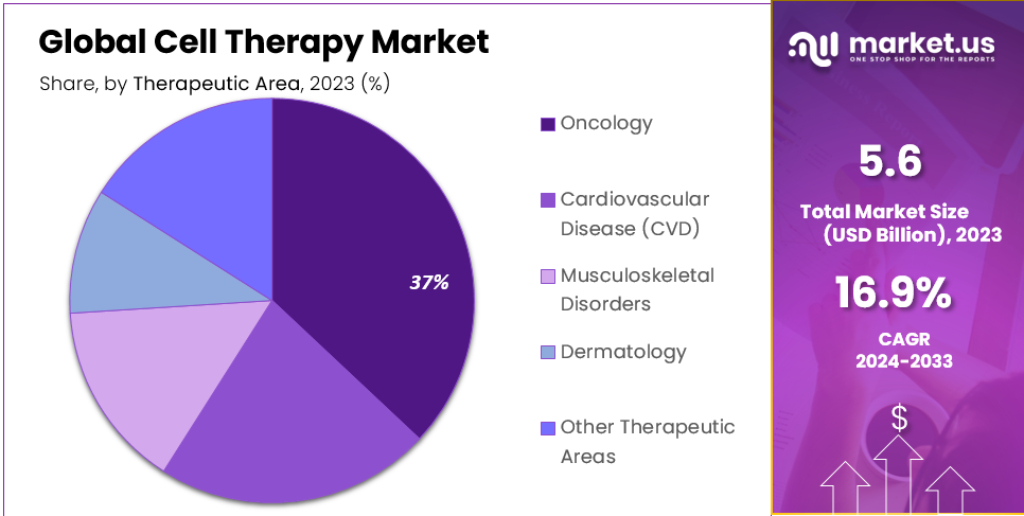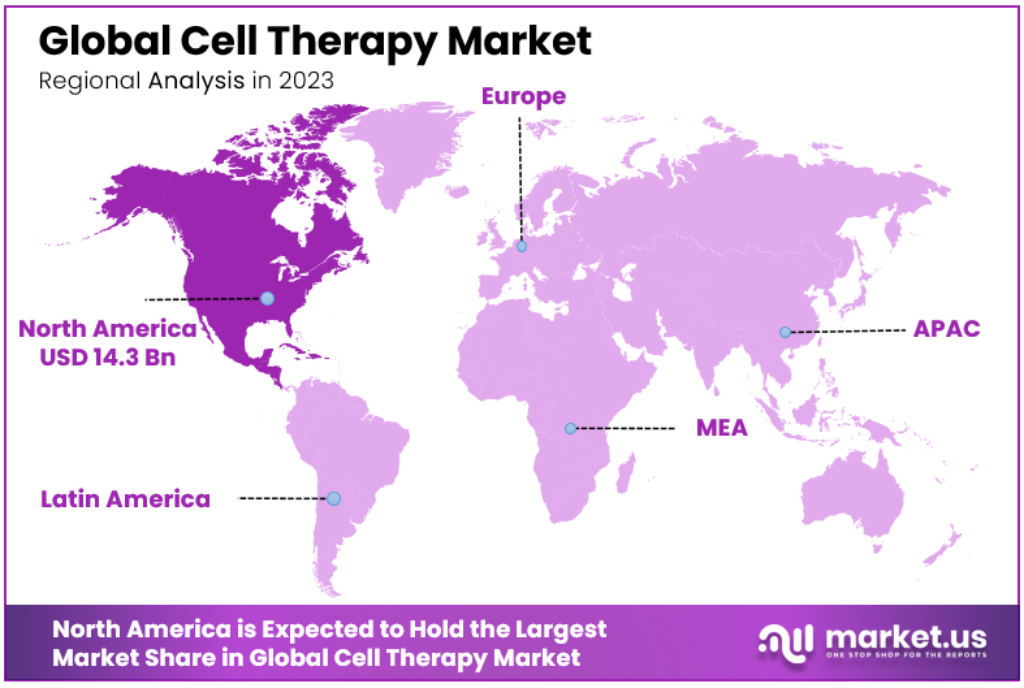Global Cell Therapy Market By Therapy Type [Allogeneic Therapies (Stem Cell Therapies (Hematopoietic Stem Cell Therapies, Mesenchymal Stem Cell Therapies), Non-Stem Cell Therapies (Keratinocytes & Fibroblast-based Therapies, Others), Autologous Therapies (Stem Cell Therapies (BM, Blood, & Umbilical Cord-derived Stem Cells, Adipose derived cells, Others), Non-Stem Cell Therapies (T-Cell Therapies, CAR T Cell Therapy, T Cell Receptor (TCR)-based, Others)] Therapeutic Area (Oncology, Cardiovascular Disease (CVD), Musculoskeletal Disorders, Dermatology, Others), By Region and Companies - Industry Segment Outlook, Market Assessment, Competition Scenario, Trends and Forecast 2024-2033
- Published date: Nov 2023
- Report ID: 37308
- Number of Pages: 250
- Format:
- keyboard_arrow_up
Quick Navigation
Cell Therapy Market Overview
The global cell therapy market size is expected to be worth around USD 26.8 Billion by 2033, from USD 5.6 Billion in 2023, growing at a CAGR of 16.9% during the forecast period from 2023 to 2033.
Cell therapy is a technology that replaces damaged or dysfunctional cells with healthy functioning cells. Because stem cells can differentiate into the cells needed to repair damaged or defective tissue, they are the main cells used in advanced therapies.
In addition, cell therapy can be used to develop regenerative medicines. Regenerative medicine is a multidisciplinary area that focuses on maintaining, improving, or restoring cell function, tissue, and cell functions using methods mainly related to cell therapy.

Key Takeaways
- The cell therapy market size will grow from USD 5.6 Billion in 2023 to about USD 26.8 Billion by 2033.
- This growth represents a CAGR of 16.9% from 2023 to 2033.
- In 2023, Autologous Therapies, which use a patient’s own cells, dominate the market with more than a 91% share.
- Oncology treatments using cell therapy have a 37% market share in 2023, showing how big a role they play in cancer treatments.
- Treatments targeting Cardiovascular Disease (CVD), like heart issues, are making a big impact on heart-related health problems.
- In 2023, North America will account for 53.4% of the global cell therapy market.
- Five of the world’s top eight universities specializing in stem cell therapy are located in the U.S.
- In the Asia Pacific region, the cell therapy industry is expected to grow at a rate of 14.6% in the coming years.
Therapy Type Analysis
In 2023, Autologous Therapies held a dominant market position, capturing more than a 91% share. These therapies use a patient’s own cells, making them more personalized. Within this segment, stem cell therapies like BM, Blood, & Umbilical Cord-derived Stem Cells and Adipose derived cells are popular. Additionally, there are non-stem cell therapies such as T-Cell Therapies, with CAR T Cell Therapy and T Cell Receptor (TCR)-based therapies showing potential.
Allogeneic Therapies involve using cells from donors. This category showcases varied therapies like Hematopoietic Stem Cell Therapies and Mesenchymal Stem Cell Therapies. Moreover, non-stem cell options like Keratinocytes & Fibroblast-based Therapies are also gaining traction.
Therapeutic Area Analysis
In 2023, Oncology led the cell therapy market, securing a significant 37% market share. This dominance underscores the important role in cell therapies, revolutionizing cancer treatment strategies. Cell therapies for Cardiovascular Disease (CVD) target heart and circulatory system conditions, representing a significant breakthrough in tackling heart-related ailments.
Musculoskeletal Disorders also found prominence in the market. Cell therapies in this segment focus on treating conditions affecting muscles, bones, and the supporting structures. Dermatology-based cell therapies are on the rise too, catering to a range of skin-related conditions and offering innovative treatment options.

Key Market Segments
Therapy Type
- Allogeneic Therapies
- Stem Cell Therapies
- Hematopoietic Stem Cell Therapies
- Mesenchymal Stem Cell Therapies
- Non-Stem Cell Therapies
- Keratinocytes & Fibroblast-based Therapies
- Others
- Stem Cell Therapies
- Autologous Therapies
- Stem Cell Therapies
- BM, Blood, & Umbilical Cord-derived Stem Cells
- Adipose derived cells
- Others
- Non-Stem Cell Therapies
- T-Cell Therapies
- CAR T Cell Therapy
- T Cell Receptor (TCR)-based
- Others
- Stem Cell Therapies
Therapeutic Area
- Oncology
- Cardiovascular Disease (CVD)
- Musculoskeletal Disorders
- Dermatology
- Others
Driver
More people are getting chronic and infectious diseases.
Cell therapy is like a detective tool for big health problems like HIV/AIDS, cancer, and other infections. Thanks to cell therapy, doctors and scientists can better understand these diseases and how to treat them. Plus, with more people in the world and the changing climate, we see new diseases popping up. Cell therapy can help tackle these new health challenges.
Restraint
Cell research is expensive and doesn’t always work out.
Researching cell therapies, like stem cell treatments, needs top-notch tools and follows strict rules. All this makes the research pricey. This is tough for smaller groups or companies who don’t have a lot of money. They might not be able to afford the high-end tools they need.
Opportunity
Making treatments just for you.
Imagine medicines made just for you! That’s what personalized medicine is about. It looks at your unique body, surroundings, and habits to decide the best treatment. This special approach is growing, especially in cancer care. It’s like a tailor-made suit, but for health!
Challenge
Hard for small companies to survive.
Big companies like Thermo Fisher and Merck have a big piece of the cell therapy market pie. This makes it tough for the little guys or newcomers to get a slice. Big companies have more money for research, while small ones struggle to keep up. It’s like a big fish in a small pond, making it hard for the small fish to grow.
Regional Analysis
North America will hold 53.4% of the world’s market share in 2023. This large Cell Therapy market share can be attributed largely to numerous centers and institutes involved in stem cell therapy R&D. Five of the 8 leading universities worldwide are U.S.-based. These include Institute for Stem Cell Biology and Regenerative Medicine, Yale Stem Cell Center, and Harvard Stem Cell Institute.
Asia Pacific’s field cell therapy industry is expected to grow 14.6% during the forecast period. It is expected that the region’s emerging economies will generate more revenue sources due to the increased investment made by both developers and consumers in advanced medical treatments. Many stem cell alliances in Asia aim to coordinate and focus on R&D. A flexible legal framework has led to patients from Western countries migrating to Asian countries to seek treatment.

Key Regions and Countries
- North America
- US
- Canada
- Mexico
- Europe
- Germany
- UK
- France
- Italy
- Russia
- Spain
- Rest of Europe
- APAC
- China
- Japan
- South Korea
- India
- Rest of Asia-Pacific
- South America
- Brazil
- Argentina
- Rest of South America
- Middle East & Africa
- GCC
- South Africa
- Israel
- Rest of MEA
Key Players Analysis
U.S. FDA approvals have been granted to numerous companies for stem-cell therapy for different diseases and infections. Stemedica Cell Technologies, Inc. was granted Investigational New Drug Approval by FDA to conduct phase II trials on intravenously administered allogeneic MSCs for covid-20 patients. They are attractive as a novel treatment for COVID-19 due to their immunomodulatory and immunogenicity.
Advanced cell therapy manufacturing includes some major key market players: Novartis AG, Gilead Sciences, Inc., Bristol-Myers Squibb Company, Johnson & Johnson Services, Inc, JCR Pharmaceuticals Co., Ltd., Tego Science, Atara Biotherapeutics, Takeda Pharmaceutical Company Limited, Bluebird Bio, Inc. and Dendreon Corp.
Маrkеt Кеу Рlауеrѕ
- Novartis AG
- Gilead Sciences, Inc.
- Bristol-Myers Squibb Company
- Johnson & Johnson Services, Inc
- JCR Pharmaceuticals Co., Ltd.
- Tego Science
- Atara Biotherapeutics
- Takeda Pharmaceutical Company Limited
- Bluebird Bio, Inc.
- Dendreon Corp.
Recent Development
- October 2023 – Allogene Therapeutics Announces Positive Topline Data from Phase 1 TRANSCEND Study of AlloCAR T38 in Patients with Relapsed or Refractory Multiple Myeloma (rrMM). The data showed that AlloCAR T38 produced high overall response rates (ORRs) and deep and durable responses in rrMM patients, with a manageable safety profile.
- September 2023 – Kite Pharma Announces Positive Topline Data from Phase 3 ZUMA-7 Study of Yescarta (axicabtagene ciloleucel) in Patients with Relapsed or Refractory Follicular Lymphoma (r/r FL). The data showed that Yescarta significantly improved progression-free survival (PFS) and overall survival (OS) in patients with r/r FL.
- August 2023 – Novartis Announces Positive Topline Data from Phase 3 CARVENO Study of Kymriah (tisagenlecleucel) in Patients with Relapsed or Refractory Large B-Cell Lymphoma (r/r LBCL). The data showed that Kymriah significantly improved PFS and OS in patients with r/r LBCL.
- July 2023 – Bristol Myers Squibb Announces Positive Topline Data from Phase 3 KarMMa Study of Breyanzi (lisocabtagene maraleucel) in Patients with Relapsed or Refractory Multiple Myeloma (rrMM). The data showed that Breyanzi significantly improved PFS and OS in patients with rrMM.
- June 2023 – Gilead Sciences Announces Positive Topline Data from Phase 3 ZUMA-3 Study of Yescarta (axicabtagene ciloleucel) in Patients with Relapsed or Refractory Diffuse Large B-Cell Lymphoma (r/r DLBCL). The data showed that Yescarta significantly improved PFS and OS in patients with r/r DLBCL.
Report Scope
Report Features Description Market Value (2023) USD 5.6 Billion Forecast Revenue (2033) USD 26.8 Billion CAGR (2023-2032) 16.9% Base Year for Estimation 2023 Historic Period 2017-2022 Forecast Period 2024-2033 Report Coverage Revenue Forecast, Market Dynamics, Competitive Landscape, Recent Developments Segments Covered Therapy Type [Allogeneic Therapies (Stem Cell Therapies (Hematopoietic Stem Cell Therapies, Mesenchymal Stem Cell Therapies), Non-Stem Cell Therapies (Keratinocytes & Fibroblast-based Therapies, Others), Autologous Therapies (Stem Cell Therapies (BM, Blood, & Umbilical Cord-derived Stem Cells, Adipose derived cells, Others), Non-Stem Cell Therapies (T-Cell Therapies, CAR T Cell Therapy, T Cell Receptor (TCR)-based, Others)]
Therapeutic Area (Oncology, Cardiovascular Disease (CVD), Musculoskeletal Disorders, Dermatology, Others)Regional Analysis North America – The US, Canada, & Mexico; Western Europe – Germany, France, The UK, Spain, Italy, Portugal, Ireland, Austria, Switzerland, Benelux, Nordic, & Rest of Western Europe; Eastern Europe – Russia, Poland, The Czech Republic, Greece, & Rest of Eastern Europe; APAC – China, Japan, South Korea, India, Australia & New Zealand, Indonesia, Malaysia, Philippines, Singapore, Thailand, Vietnam, & Rest of APAC; Latin America – Brazil, Colombia, Chile, Argentina, Costa Rica, & Rest of Latin America; Middle East & Africa – Algeria, Egypt, Israel, Kuwait, Nigeria, Saudi Arabia, South Africa, Turkey, United Arab Emirates, & Rest of MEA Competitive Landscape Novartis AG, Gilead Sciences, Inc., Bristol-Myers Squibb Company, Johnson & Johnson Services, Inc, JCR Pharmaceuticals Co., Ltd., Tego Science, Atara Biotherapeutics, Takeda Pharmaceutical Company Limited, Bluebird Bio, Inc., Dendreon Corp. and Other Key Players. Customization Scope Customization for segments, region/country-level will be provided. Moreover, additional customization can be done based on the requirements. Purchase Options We have three licenses to opt for: Single User License, Multi-User License (Up to 5 Users), Corporate Use License (Unlimited User and Printable PDF) Frequently Asked Questions (FAQ)
Whаt іѕ thе рrојесtеd САGR аt whісh thе Сеll Тhеrару Маrkеt іѕ ехресtеd tо grоw аt?Тhе Сеll Тhеrару Маrkеt іѕ ехресtеd tо grоw аt а САGR оf 16.9% (2023-2033).
Lіѕt thе ѕеgmеntѕ еnсоmраѕѕеd іn thіѕ rероrt оn thе Сеll Тhеrару Маrkеt?Маrkеt.UЅ hаѕ ѕеgmеntеd thе Сеll Тhеrару Маrkеt bу gеоgrарhіс (Nоrth Аmеrіса, Еurоре, АРАС, Ѕоuth Аmеrіса, аnd Міddlе Еаѕt аnd Аfrіса). By Therapy Type [Allogeneic Therapies (Stem Cell Therapies - Hematopoietic Stem Cell Therapies and Mesenchymal Stem Cell Therapies) (Non-Stem Cell Therapies - Keratinocytes & Fibroblast-based Therapies and Others) Autologous Therapies (Stem Cell Therapies - BM, Blood, & Umbilical Cord-derived Stem Cells, Adipose derived cells and Others) (Non-Stem Cell Therapies - T-Cell Therapies, CAR T Cell Therapy, T Cell Receptor (TCR)-based and Others)] By Therapeutic Area [Oncology, Cardiovascular Disease (CVD), Musculoskeletal Disorders, Dermatology and Others]
Lіѕt thе kеу іnduѕtrу рlауеrѕ оf thе Сеll Тhеrару Маrkеt?Novartis AG, Gilead Sciences, Inc., Bristol-Myers Squibb Company, Johnson & Johnson Services, Inc, JCR Pharmaceuticals Co., Ltd., Tego Science, Atara Biotherapeutics, Takeda Pharmaceutical Company Limited, Bluebird Bio, Inc., Dendreon Corp. аnd Оthеr Кеу Рlауеrѕ аrе еngаgеd іn thе Сеll Тhеrару mаrkеt
Whісh rеgіоn іѕ mоrе арреаlіng fоr vеndоrѕ еmрlоуеd іn thе Сеll Тhеrару Маrkеt?Nоrth Аmеrіса іѕ ехресtеd tо ассоunt fоr thе hіghеѕt rеvеnuе ѕhаrе оf 53.4%. Тhеrеfоrе, thе Сеll Тhеrару іnduѕtrу іn Nоrth Аmеrіса іѕ ехресtеd tо gаrnеr ѕіgnіfісаnt buѕіnеѕѕ орроrtunіtіеѕ оvеr thе fоrесаѕt реrіоd.
Nаmе thе kеу аrеаѕ оf buѕіnеѕѕ basis of region fоr Сеll Тhеrару?Тhе UЅ, Іndіа, Сhіnа, Саnаdа, UК, Јараn, Gеrmаnу, Saudi Arabia аrе kеу аrеаѕ оf ореrаtіоn fоr thе Сеll Тhеrару Маrkеt.
Whісh ѕеgmеnt ассоuntѕ fоr thе largest share іn thе Сеll Тhеrару іnduѕtrу?Wіth rеѕресt tо thе Сеll Тhеrару іnduѕtrу, vеndоrѕ саn ехресt tо lеvеrаgе grеаtеr рrоѕресtіvе buѕіnеѕѕ орроrtunіtіеѕ thrоugh thе Rеѕеаrсh-uѕе ѕеgmеnt, аѕ thіѕ аrеа оf іntеrеѕt ассоuntѕ fоr thе lаrgеѕt mаrkеt ѕhаrе.

- Novartis AG Company Profile
- Gilead Sciences, Inc.
- Bristol-Myers Squibb Company
- Johnson & Johnson Services, Inc
- JCR Pharmaceuticals Co., Ltd.
- Tego Science
- Atara Biotherapeutics
- Takeda Pharmaceutical Company Limited
- Bluebird Bio, Inc.
- Dendreon Corp.
- settingsSettings
Our Clients
| Single User $4,599 $3,499 USD / per unit save 24% | Multi User $5,999 $4,299 USD / per unit save 28% | Corporate User $7,299 $4,999 USD / per unit save 32% | |
|---|---|---|---|
| e-Access | |||
| Report Library Access | |||
| Data Set (Excel) | |||
| Company Profile Library Access | |||
| Interactive Dashboard | |||
| Free Custumization | No | up to 10 hrs work | up to 30 hrs work |
| Accessibility | 1 User | 2-5 User | Unlimited |
| Analyst Support | up to 20 hrs | up to 40 hrs | up to 50 hrs |
| Benefit | Up to 20% off on next purchase | Up to 25% off on next purchase | Up to 30% off on next purchase |
| Buy Now ($ 3,499) | Buy Now ($ 4,299) | Buy Now ($ 4,999) |












